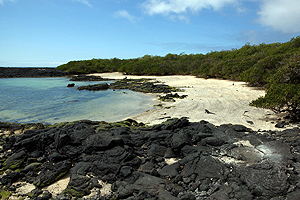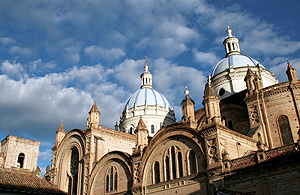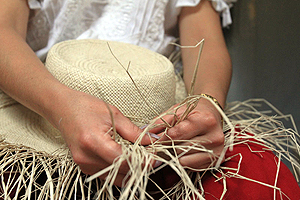
UNESCO
The following places in Ecuador are currently declared as UNESCO World Heritage Sites/Centres:
CULTURAL AND NATURAL HERITAGE
GALAPAGOS ISLANDS
 Registered in 1978, extended in 2001.
Registered in 1978, extended in 2001.
Located in the Pacific, about a thousand kilometres from the South American continent, these 19 volcanic islands and surrounding marine reserve are a museum and a living laboratory of evolution, unique in the world. The Galapagos are located at the confluence of three ocean currents and concentrate a wide variety of marine species. Its seismic and volcanic activity illustrates the process of its geological formation. These processes, together with the extreme isolation of the archipelago, has led to the development of unique wildlife species such as the land iguana, the giant tortoise and many species of finches, whose study inspired Darwin's Theory of Evolution by Natural Selection, after a trip to the islands in 1835 (UNESCO / BPI).
QUITO
 Cultural heritage registered in 1978.
Cultural heritage registered in 1978.
Founded in the 16th century on the ruins of an ancient Inca city perched 2850 meters above sea level, the capital of Ecuador has the best-preserved and least altered historic centre in Latin America, despite the earthquake that struck in 1917. Sumptuously decorated on the inside, the monasteries of San Francisco and Santo Domingo, as well as the church and school of the Compañía de Jesús (Society of Jesus), are perfect examples of the art of the Baroque school of Quito, in which Spanish, Italian, Moorish, Flemish and indigenous aesthetic influences merge (UNESCO / BPI).
SANGAY NATIONAL PARK
Natural heritage registered in 1983.
This park of outstanding natural beauty has two active volcanoes and a full range of ecosystems, from tropical rainforests to glaciers. Its landscapes offer striking contrasts between snow-capped peaks and flatland forests. Moreover, its isolation facilitates the protection of the endangered species that populate it, such as the mountain tapir and the Andean condor (UNESCO / BPI).
SANTA ANA RIVER BASIN (CUENCA)
 Cultural heritage registered in 1999.
Cultural heritage registered in 1999.
Santa Ana de los Ríos de Cuenca is nestled in a valley of the southern Andes of Ecuador. This colonial city, which is currently the third largest in the country, was founded in 1557, in accordance with the strict planning regulations promulgated thirty years earlier by Emperor Charles V. The urban layout of the city is still adjusting to the orthogonal plan established 400 years ago. Cuenca is now a regional agricultural and administrative centre, where the local population has mixed with successive generations of migrants. Most of the buildings date from the 18th century, but modernized urban architecture came with the economic prosperity that benefited the city in the 19th century when it became a major export hub for quinine, straw hats and other products (UNESCO / BPI).
INTANGIBLE HERITAGE
Presently, Ecuador has two elements registered on the list of Intangible
Oral heritage and cultural manifestations of the Zápara Peoples Intangible heritage registered in 2008 (originally proclaimed in 2001).
This information is shared with Peru
The Zápara live in a region of the Amazon rainforest located between Peru and Ecuador. Based in one of the world's richest biodiversity regions, they are the last representatives of an ethno-linguistic group that included many other populations, before the Spanish conquest. In the heart of the Amazon, they have developed an oral culture particularly rich in knowledge of the natural environment, as demonstrated by the abundance of their vocabulary for the flora and fauna, as well as their knowledge of medicinal plants in the forest. This cultural heritage is expressed through myths, rituals, artistic practices and language. This repository of knowledge and oral tradition constitutes the memory of the entire region.
Four centuries of history, marked by the Spanish conquest, slavery, epidemics, forced conversions, wars and deforestation have decimated these peoples. However, despite many threats, they have managed to preserve their ancestral knowledge. Through intermarriage with other Indigenous Peoples (Quechua and mestizo), they have survived. This dispersion, however, has also implied a loss of part of their identity.
The current situation of the Zápara is critical and does not exclude the risk of extinction. In 2001, the total number of Zápara was no more than 300 (200 in Peru and 100 in Ecuador), of which only five, now over 70 years of age, still speak the Zápara language (UNESCO / BPI).
Traditional Weaving of the Ecuadorian Panama Hat
 Intangible heritage registered in 2012.
Intangible heritage registered in 2012.
The Panama hat is woven with the fibres of a palm tree that grows particularly on the Ecuadorian coast. Coastal farmers cultivate toquillales and collect the stems in order to then separate the green bark fibre, boiling the latter to remove the chlorophyll and then drying it with charcoal and bleaching it with sulphur. The weavers use these raw materials to prepare the pattern, the cup and the brim of the hat. The fabric of a hat can last anywhere from one day to eight months, depending on quality and finesse. In the coastal community of Pile, weavers make superfine hats requiring specific climatic conditions and an exact number of points in each row of the weave. The preparation is finalized with a series of washing, bleaching, baking, ironing and pressing. The weavers are mostly peasant families and weaving techniques are transmitted to children at home, by observation and imitation, from a very early age. The techniques and skills encompass a complex and dynamic social fabric comprising, inter alia, the traditional techniques of cultivation and production, various forms of social organization and use of the hat as part of the everyday and festive attire. For communities that perpetuate this tradition of craftsmanship, it represents a hallmark of their identity and component of cultural heritage (UNESCO / BPI).

















